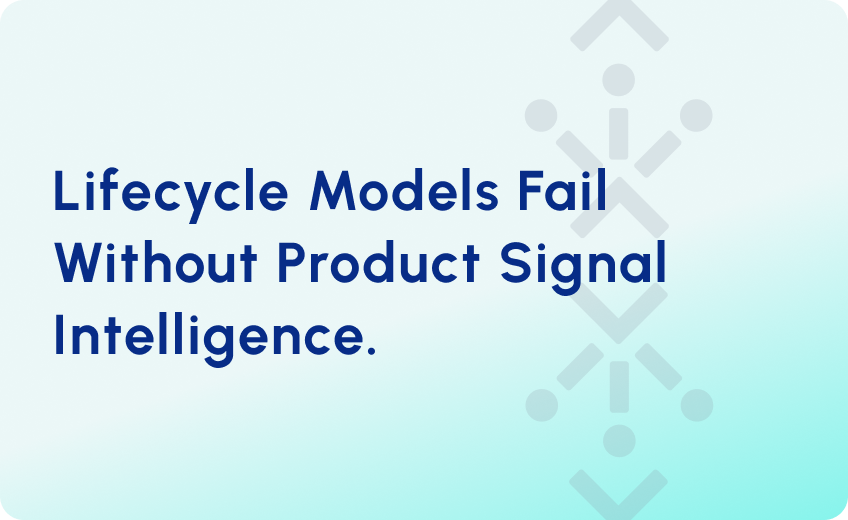
Identifying and fixing leakages in your B2B Lifecycle Model
Most B2B teams are great at building funnels. But very few know where they’re leaking.
The focus is usually on getting leads in — not tracking what happens after. But revenue doesn’t just drop at “closed-won.” It’s earned (or lost) across the entire lifecycle: onboarding, retention, and expansion.
The problem? Most lifecycle models are implemented once and never optimized.
In this article, we’ll map out where the biggest leaks happen — and how to fix them — so your revenue engine captures more value at every stage.
Leak #1: Inefficient Lead Capture and Qualification
Most funnels start leaking before anyone notices, i.e. right at the point of entry.
This leak also shows up when teams rely too heavily on form fills without enriching or segmenting the leads afterward. You end up with a bloated database full of people you can’t route, score, or activate.
How to track it:
- Audit how many leads are being disqualified at the top of the funnel and why.
- Look at your form-to-CRM sync health: Are there any sync errors or missing fields?
- Check how many leads are missing key firmographic data (like industry, size, job title).
- Compare data from ad platforms like LinkedIn Lead Gen, Ads etc. to actual engagements recorded in your CRM to catch uncaptured interest.
How to fix it:
- Standardize lead capture across all sources — including forms, chat, content downloads, and partner referrals.
- Add enrichment tools (like Clearbit, ZoomInfo, or your MAP’s native features) to automatically fill gaps in lead data.
- Align Marketing and Sales on what constitutes a sales ready lead. Create and document your scoring logic based on demographic, firmographic, and behavioral intent.
- Build dashboards to monitor lead flow and flag any drops in capture or quality in real time.
Leak 2: Marketing and Sales Handoff Gaps
This is one of the most common (and costly) leakages in a lifecycle model. The root cause of this leak is usually a lack of coordination. There’s no clear owner of the lead, no agreed SLA for follow-up, and no visibility into whether Sales acted on it. Sometimes, leads get routed to the wrong person or not get routed at all, or they get lost in a sea of notifications. Either way, the handoff breaks down.
How to track it:
- Measure the average time it takes for a rep to take the first action after an MQL is created.
- Identify what percentage of MQLs go untouched for more than 48–72 hours.
- Audit lead routing rules regularly to catch incorrect assignments, duplicates, or dead ends.
How to fix it:
- Define and document clear SLAs between Marketing and Sales (e.g., “All MQLs must be touched within 24 hours”).
- Automate routing and notifications via CRM notifications / email and Slack to reduce manual error. Make sure every MQL lands with the right owner.
- Build a dashboard that tracks MQL-to-SQL conversion lag and flags stale leads automatically.
- Schedule monthly reviews to align Marketing and Sales on lead quality, conversion rates, and process gaps.
Leak #3: Sales Pipeline Stalls
This kind of leakage is hidden in plain sight. The deal is technically “active” in your CRM, but there’s no movement, no engagement, and no next steps. Pipeline stalls usually happen when reps aren’t sure what to do next or they’re juggling too many deals. It can also be a signal that the buyer has gone cold. Maybe they lost interest, got busy, or were never that qualified to begin with. Either way, your pipeline is bloated, and forecasting becomes unreliable.
How to track it:
- Identify opportunities with no activity (emails, calls, meetings) in the past 7–14 days.
- Measure average time in stage vs. your defined benchmarks — flag anything significantly over.
- Calculate the stagnation rate — the % of deals that haven’t progressed in last X days.
How to fix it:
- Set up activity alerts for reps and managers when a deal goes cold.
- Require reps to log next steps or a clear reason before moving an opp to the next stage.
- Equip sellers with enablement assets (case studies, ROI calculators, objection-handling decks) to re-engage buyers.
- Conduct regular pipeline reviews focused not just on size, but deal health — how much is actually progressing?
Leak #4: Billing and Contract Management Errors
Even satisfied customers can churn or downgrade due to administrative errors like incorrect invoices, missed renewals, or legal delays.
This is a frustrating — and surprisingly common — source of revenue leakage. Operational breakdowns in billing, contracts, and quote-to-cash processes can delay payment, strain customer relationships, and even cause deals to fall through.
How to track it:
- % of invoices sent late or with errors
- Time from closed-won to invoice sent or payment received
- Volume of renewal deals delayed due to contract or billing issues
How to fix it:
- Integrate your CRM, CPQ, contract, and billing systems for a seamless quote-to-cash workflow
- Use automated approval workflows for contract generation and redlines
- Implement renewal playbooks with clear internal handoffs and owner accountability
- Regularly audit billing accuracy and process bottlenecks — don’t wait for customers to flag them
Leak #5: Poor Customer Onboarding & Adoption
Too many B2B companies treat “closed-won” as the finish line, when in reality, it’s just the halfway point. If onboarding is slow, chaotic, or inconsistent, customers are more likely to disengage early and never realize the value they were promised. That’s a surefire path to low adoption, poor NPS, and eventual churn.
How to track it:
- Monitor time-to-onboarding kickoff after a deal is marked closed-won.
- Track the percentage of customers completing onboarding within 30, 60, or 90 days.
- Use product analytics to measure activation and usage metrics during the first 90 days.
- Flag accounts with low engagement or with sudden engagement changes early.
How to fix it:
- Build a standardized onboarding playbook with clear roles and milestones.
- Use automated onboarding sequences (emails, in-app walkthroughs, task reminders) to guide new users.
- Assign a clear owner for each new account — don’t let them sit in limbo.Implement onboarding health scores that combine timeline, usage, and engagement signals to proactively spot risk.
Leak #6: Customer Churn at Renewal
Customers silently disengage over time, and by the time renewal comes around, they’re halfway out the door (or already gone). By the time a customer says they’re not renewing, the damage has usually been done. Maybe they didn’t see the value. Maybe they haven’t heard from you in months. Maybe key champions left and no one rebuilt the relationship. Whatever the reason, the decision to churn was made long before the renewal conversation even started.
How to track it:
- Monitor churn rates by engagement, product usage, or account type.
- Track how many renewals are flagged as “at risk” within 60 days of term end.
- Watch for leading indicators: declining product usage, low NPS/CSAT scores, or spikes in support tickets.
- Check how often renewals happen without an active QBR or account conversation in the prior quarter.
How to fix it:
- Start renewal planning 90–120 days out, not 30.
- Set up automated health scoring based on product usage, engagement, sentiment, and support history.
- Make regular check-ins part of your standard cadence.
- Build early warning dashboards that flag at-risk accounts based on behavior trends and feedback signals.
Leak #7: Missed Upsell and Expansion Opportunities
Expansion is one of the most underutilized revenue levers in B2B. Existing customers are familiar with your brand, already see some value, and often have untapped potential across teams, geographies, or products. Yet upsell and cross-sell motions are often reactive or non-existent, relying on reps to “just notice” when the time is right.
This leak usually stems from a lack of visibility into product usage, account growth signals, or customer needs over time.
How to track it:
- Measure expansion revenue as a % of total revenue — and set targets by segment
- Track % of customers with expansion potential but no open opportunity.
- Use product analytics to identify usage growth, feature interest, or new users from other departments.
- Monitor account engagement with content related to other products or services.
How to fix it:
- Align CS and Sales on expansion triggers — usage milestones, seat saturation, or multi-team engagement.
- Set up alerts for product usage spikes, new logins from different domains, or support requests related to add-ons.
- Introduce cross-sell and upsell playbooks, including tailored messaging, sales enablement, and timing recommendations.
How Can RevOps Global Help?
Revenue leaks aren’t always obvious — but they’re always costly. Fixing even one or two of these gaps can unlock serious growth across your funnel.
At RevOps Global, we help B2B teams identify and fix these exact issues — with data, not guesswork. Book a 1:1 demo to see how!




